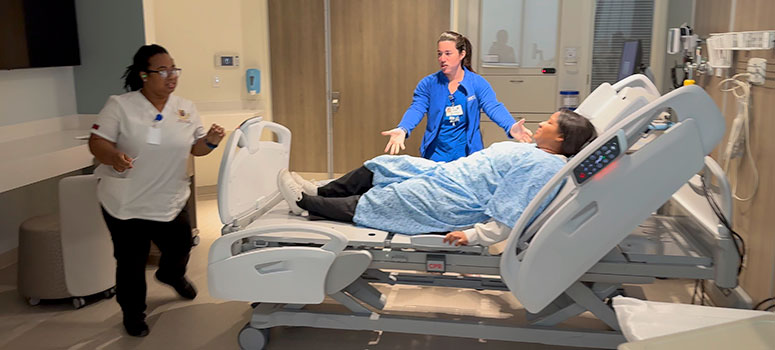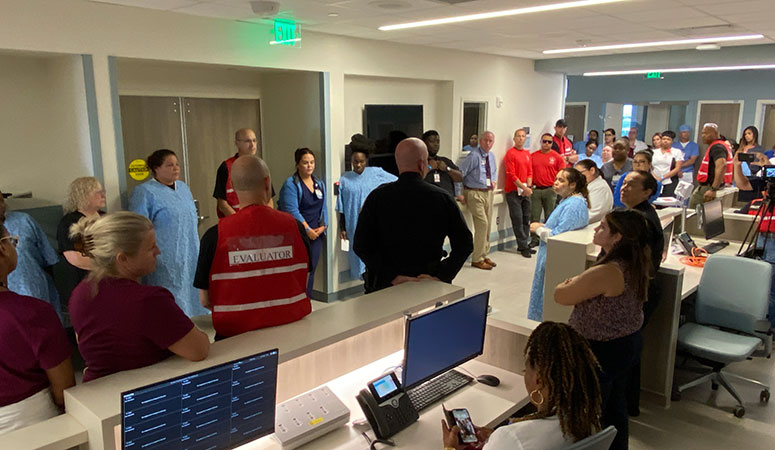Moffitt Staff Shows Courage During Active Shooter Drill
In an unwavering display of preparedness and teamwork, Moffitt Cancer Center joined forces with the Tampa Police Department and local law enforcement for an active shooter drill that left a lasting impression on all. With nerves of steel and a commitment to the safety of patients and team members, the hospital and local law enforcement’s response showcased dedication to protecting and saving lives.
The active shooter drill was conducted at Moffitt McKinley Hospital, the cancer center’s new inpatient surgical facility opening in late July, and included nearly 300 volunteer participants, Moffitt team members, law enforcement and county officials. For local law enforcement, this was a once-in-a-lifetime opportunity to practice emergency response drills in an empty health care setting.
TOMORROW at 12 PM- TPD will be conducting an active shooter exercise at Moffitt McKinley Hospital. The incident is not real, but response efforts will be realistic.
— Tampa Police Department (@TampaPD) June 13, 2023
Large officer presence, road closures, and facility closures are expected for the duration of the exercise. pic.twitter.com/d9gtLIh7Sz
Moffitt’s Vice President of Facilities and Support Services Terrence Wright oversees safety and security at the cancer center. He says the biggest takeaways for an exercise like this are the lasting impacts on preparing and educating Moffitt’s team members, and the collaboration between the center and local law enforcement.

Terrence Wright. Vice President, Facilities and Support Services
“We have patients in the building that can’t protect themselves from danger in these situations, so we train our staff to do that,” Wright said. “These events can happen anywhere. Training for this and educating our staff helps us all have situational awareness that can help protect us no matter where we are.”
As the drill unfolded, a flurry of activity erupted throughout the hospital. The shooter, played by a trained police officer, used a handgun and assault rifle loaded with simulated ammunition to carry out the mock scenario. As the assailant began his assault, the blaring code announcements over the intercom simulated the chaos that ensues during such a crisis.
The sounds of gunshots echoed through the crowded hallways as participants reacted according to their assigned role. To replicate real-life reactions, some actors were asked to run while others hid in whatever spaces they could find. A small group was instructed to fight the shooter or panic to the responding officers on the scene.
Moffitt’s emergency response teams and staff demonstrated exceptional courage and composure. Their proficiency showcased the level of preparedness instilled throughout the hospital. They prioritized patient safety, moving them to secure locations and barricading patient rooms, while simultaneously attending to those that were assigned injuries during the simulation. Their meticulous planning and execution proved invaluable in maintaining a sense of order amid the turmoil.
With the Tampa Police Department’s arrival on the scene, a seamless collaboration emerged between the hospital staff and law enforcement officers. Armed with their extensive training, the officers swiftly neutralized the simulated threat, ensuring that the hospital was once again safe and secure.

Students from Jersey College of Medicine were patients and visitors for the active shooter drill. The exercise was an opportunity for Moffitt staff to practice their response to run, hide or fight.
Together, Tampa Police and Moffitt Cancer Center ran through multiple drills representing real situations that have recently unfolded across the country at various hospitals. Teams practiced their emergency response to hostile interactions, hostage situations and standoffs with the gunman.
After the exercise, the smell of sulfur from discharged firearms hung in the air as participants were debriefed and shared their observations, discussing areas of improvement and acknowledging the successes. Valuable lessons were learned, allowing the hospital to refine their emergency response procedures even further.
“Our success in drills like these serve as a powerful reminder that, in the darkest of times, Moffitt’s compassion, courage and united front will always prevail,” Wright said. “We prepared for the worst and emerged stronger, ready to face any challenge that comes our way.”
Drills like these are a growing part of Moffitt’s overall goal to enhance safety on its campuses. Later this summer, the cancer center will deploy a new visitor management system to better track the movement through its doors.

Tampa Police Chief Lee Bercaw, center in black, debriefs the group during the drill. Tampa Police and Moffitt had a unique opportunity to practice their response at Moffitt McKinley Hospital before it opens in late July.



